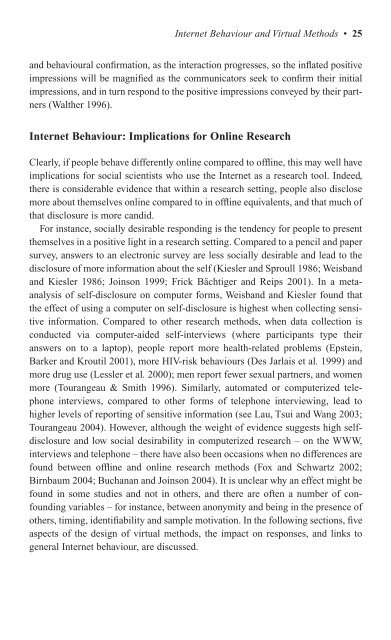Virtual Methods
Virtual Methods
Virtual Methods
You also want an ePaper? Increase the reach of your titles
YUMPU automatically turns print PDFs into web optimized ePapers that Google loves.
Internet Behaviour and <strong>Virtual</strong> <strong>Methods</strong> • 25<br />
and behavioural confirmation, as the interaction progresses, so the inflated positive<br />
impressions will be magnified as the communicators seek to confirm their initial<br />
impressions, and in turn respond to the positive impressions conveyed by their partners<br />
(Walther 1996).<br />
Internet Behaviour: Implications for Online Research<br />
Clearly, if people behave differently online compared to offline, this may well have<br />
implications for social scientists who use the Internet as a research tool. Indeed,<br />
there is considerable evidence that within a research setting, people also disclose<br />
more about themselves online compared to in offline equivalents, and that much of<br />
that disclosure is more candid.<br />
For instance, socially desirable responding is the tendency for people to present<br />
themselves in a positive light in a research setting. Compared to a pencil and paper<br />
survey, answers to an electronic survey are less socially desirable and lead to the<br />
disclosure of more information about the self (Kiesler and Sproull 1986; Weisband<br />
and Kiesler 1986; Joinson 1999; Frick Bächtiger and Reips 2001). In a metaanalysis<br />
of self-disclosure on computer forms, Weisband and Kiesler found that<br />
the effect of using a computer on self-disclosure is highest when collecting sensitive<br />
information. Compared to other research methods, when data collection is<br />
conducted via computer-aided self-interviews (where participants type their<br />
answers on to a laptop), people report more health-related problems (Epstein,<br />
Barker and Kroutil 2001), more HIV-risk behaviours (Des Jarlais et al. 1999) and<br />
more drug use (Lessler et al. 2000); men report fewer sexual partners, and women<br />
more (Tourangeau & Smith 1996). Similarly, automated or computerized telephone<br />
interviews, compared to other forms of telephone interviewing, lead to<br />
higher levels of reporting of sensitive information (see Lau, Tsui and Wang 2003;<br />
Tourangeau 2004). However, although the weight of evidence suggests high selfdisclosure<br />
and low social desirability in computerized research – on the WWW,<br />
interviews and telephone – there have also been occasions when no differences are<br />
found between offline and online research methods (Fox and Schwartz 2002;<br />
Birnbaum 2004; Buchanan and Joinson 2004). It is unclear why an effect might be<br />
found in some studies and not in others, and there are often a number of confounding<br />
variables – for instance, between anonymity and being in the presence of<br />
others, timing, identifiability and sample motivation. In the following sections, five<br />
aspects of the design of virtual methods, the impact on responses, and links to<br />
general Internet behaviour, are discussed.



